
33 minute read
President
P
PRESIDENT
Mark Carroll
Ratified EA to address staffing issues
The Police Association continues to receive member complaints about staffing.
The impact of COVID-19 continues to impose extra burdens on all police officers across a range of functions.
I have raised issues with Commissioner Grant Stevens about areas such as Southern District Response, district policing teams, Riverland CIB, Hindley St patrols and the broader eastern district.
A long-running industrial dispute also exists about staffing issues on Kangaroo Island.
Then there’s the APY Lands staffing model. The association is at odds with SAPOL over the model, as well as the overall continual vacancies in country locations.
However, the newly ratified enterprise agreement provides for implementation of a raft of measures to address staffing concerns.
Voluntary return to service
A system enabling employees to voluntarily access ad hoc shifts across districts and functions in areas of high demand will soon be trialled.
The principles that underpin the system include: • Utilizing the workforce in a different way. • Being voluntary for appropriately qualified (IMOST) full-time and part-time members. • Payments attracting relevant penalty rates for the ad hoc shift worked. • Operating outside of prescriptive award conditions so as not to incur overtime unless the shift extends beyond the designated ad hoc shift time. A system enabling employees to voluntarily access ad hoc shifts across districts and functions in areas of high demand will soon be trialled.
Participating members will only be eligible while they are on rostered or programmed days off, or approved leave (including annual, long-service or parental leave or leave without pay).
SAPOL will soon provide full details regarding voluntary return to service. The system will be applied to COVID-19 duties as the first priority.
Employment of protective security officers
The Statutes Amendment and Repeal (Budget Measures) Bill 2020 establishes a legislative framework for the new role of “police security officer” within the Police Act 1998.
The existing Protective Security Act 2007 will be repealed, and protective security officers will be renamed police security officers. Their duties will be expanded to include functions traditionally performed by police.
These roles will include cell guard duties, summons delivery and warrant enquiries, hospital guard duties, crowd management at major events, prisoner transport and 000 call-taking.
The implementation of PSOs into these roles might adjust the sworn establishment range.
This new initiative will not change the need for sworn establishment numbers to grow over time.
SAPOL renewal programme
A renewal programme/early retirement scheme (which meets ATO requirements) will be developed to support cessation of a role or position that is no longer required to be performed by a police officer. The programme will be voluntary.
Details are still to follow, but discussions will begin now that formal ratification of the enterprise agreement has taken place.
User-pay system for police resources
SAPOL has finalized a user-pay for police resources model that would have utilized sworn officers to access user-pay shifts outside of their normal roster or function.
Owing to the impact of COVID-19, this model has been placed on hold for the foreseeable future. Workplace stress and work intensification owing to a lack of staff
Oppressive workloads are potential occupational health and safety hazards. Such hazards might cause unnecessary workplace stress, anxiety, mental ill health or physical fatigue.
All members should report risks or hazards pursuant to general order 8540. First, notify your supervisor (and keep a personal record of that notification) about the lack of staff allocated to a shift (or series of shifts) and its potential to create a risk or workplace hazard.
Enquire about what action your supervisor will take to address your concern. Detail any warning indicators. Outline injuries you might have suffered owing to the hazard.
Your supervisor should act in accordance with the Work Health and Safety Act 2012, the SAPOL Staffing Needs on a Shift Basis general order, and general order 8540 and/or clause 45 of the SAPOL Enterprise Agreement 2021.
If you are not satisfied with your supervisor’s response, immediately notify your local health and safety representative. The HSR should raise the issue with local management.
If this does not resolve your concern, submit a hazard and incident report. The HSR is responsible for representing the workgroup after submitting an HIR.
If the matter is not resolved, the HSR should issue a provisional improvement notice in accordance with the Work Health and Safety Act 2012.
Members should provide the association with a PDF copy of the HIR (e-mail to staffing@pasa.asn.au) and notify the local workplace delegate.
The association will assess the outcome of the hazard and, if it is not resolved, raise the issue with SAPOL.
If the hazard has created a workplace injury, submit a Workcover notification.
How will the Police Association of SA respond?
Successful resolution of workplace issues depends on adherence to formal legislative framework and procedures.
Members must adhere to the requirement to follow SAPOL procedures in notifying hazards, risks
and workplace injuries. Everyone has a duty to maintain a safe workplace.
Hazard incident reports are paramount in giving the employer the opportunity to remedy the situation or prevent a likely contravention.
Following these procedures enables the Police Association to advocate on behalf of members and, if necessary, seek industrial recourse.
The association process insofar as workplace hazards includes: • Ensuring that legislative requirements and reporting procedures have been met. • Assisting members to report hazards. • Raising the hazard with appropriate
SAPOL managers. • Ensuring SAPOL has made an appropriate, immediate response to remedy the hazard and monitor this response. • Ensuring SAPOL employee assistance protocols are enacted. • Assisting members with workers compensation matters owing to any injuries sustained. • Commencing, if required, formal dispute procedures.
What if the hazard is systemic?
Some members might be reluctant to report a hazard they consider to be systemic in nature.
For example, there might be insufficient staff in response teams because of resources allocated to meet other district requirements.
Or a particular workgroup or function might not have sufficient resources to respond adequately to ever-increasing workloads.
Members should not hesitate to notify their managers in these instances. This could be via a workplace consultative committee or daily tactical co-ordination group.
Members should also submit a HIR and notify the Police Association (staffing@pasa.asn.au) and the workplace delegate.
The association will advocate on the member’s behalf and hold meetings with affected members to discuss the facts surrounding each case.
Ultimately, successful resolution of systemic issues requires member-wide engagement.
Remember Ink?
Left: Police dog Ink with handler Tony Potter. Dog Ops handler Senior Constable First Class Tony Potter never could describe his relationship with his dog, Ink. It was that special; and 10 months later, he still feels the pain of losing his old mate.
By Brett Williams
og Ops handler Tony Potter jumped clear as the two would-be ATM thieves drove straight at him in their getaway car. Luckily uninjured, he immediately D around 2 o’clock on a dark June morning in 2014. The police communications centre called for a patrol to respond to an alarm at O’Halloran Hill. It was on looked for his partner, German shepherd police the Hilltop Shopping Centre and Potter and Ink were dog Ink, and spotted him “curled up in a ball on close by, just on Majors Road. the ground”. Potter, when he heard the call, thought: “We’re on Potter did not yet know it, but Ink had taken here, big time!” and headed for the complex. He pulled a savage beating from the now fleeing criminals. up in front of the ATMs but could see no one around They had broken four of his ribs and ruptured a them, or inside the building as he peered through its disc in his spine. glass frontage. But his attackers were about to crash their car. So, Potter got Ink out his patrol car and set about Karma, some would call it. Police would catch one checking the entire perimeter of the building. Once at the crash scene and the other a few days later. around the back, he spotted the two offenders, both Ink, meanwhile, strained to get himself up off wearing balaclavas. Startled by Potter and Ink, the the ground. He managed it but, once he was upright, pair bolted. Potter could see an arch in his back and his body “So,” Potter says, “I yelled out my challenge: literally bent out of shape. “Buckled”, he called it. ‘Police with a dog! Stop where you are!’ But they And with all his then unknown injuries, Ink took a run for it. ” tried to walk but got only a few steps before he The challenge was in line Dog Ops training and, simply collapsed. once issued, gave Potter every justification to release Says Potter: “I thought: ‘Shit, we’re in trouble here! Ink to chase the offenders. So, Ink bolted, and Potter He’s in a pretty bad way.’ ” followed but, within just 100 metres, lost sight of That trouble had started just a few minutes earlier, the dog in the darkness.
And, unknown to Potter, was that the offenders were headed for their getaway car. They had left it parked behind a retaining wall adjacent to the shopping centre car park.
Ink was right behind them as they charged around the corner of the wall and toward their car. Potter, breathless from the chase, turned the corner a few moments later.
“By that time,” he says, “the headlights (of the getaway car) just came on, and I had no perspective of where my dog was at that point. The car just started to drive straight towards me. I jumped out of the way because they actually tried to hit me and then took off. ”
That was when Potter looked for, and spotted, Ink curled up on the ground before the creature struggled o his feet but then collapsed.
It would later emerge that one offender, the first Ink had tried to grab, had belted him with a metal case for oxyacetylene nozzles.
The other offender had repeatedly slammed one of the car doors on Ink as the dog tried to stop him getting away.
But now, an extremely worried Potter called for back-up. “My dog’s down!” he exclaimed. “I need urgent help!” But the help he needed – as Ink lay motionless in a corner of the shopping centre car park – was not from patrols but rather a vet.
“Everyone jumped on board,” Potter says. “Bosses even came up on air and said: ‘We’ll find an emergency vet. Use lights and sirens, whatever you need to do.’ ”
But what Potter first had to do was somehow lift Ink, a seriously injured 40kg dog, into his patrol car. He rightly feared that by picking him up he could cause him more damage.
“I just thought: ‘I’ve got to get him to medical help,’ ” Potter recalls. “So, I scooped him up as best I could and as gently as I could. I then had to manipulate him into one of the pods and lay him down as gently as possible.
“The emergency vet was down on Anzac Highway. I went there as fast as I could, thinking: ‘I hope he’s all right back there (in the pod).’ ”

1: Ink after surgery to repair his punctured lung and broken ribs. 2: Ink receiving treatment at the animal hospital after the attack. 3: Potter paying Ink a visit a few days after his surgery. 4: Ink on his graduation day with Potter (right) and fellow handler SC1C Bryan Whitehorn with Ink’s brother, Ike.
Soon after 2am, Ink was
in the veterinary surgery getting medication to relieve his pain, calm him, and steady his breathing. He underwent X-rays, too, to shed light on the extent of his broken bones.
For around the next 24 hours, vets kept Ink under observation until he was stable. Surgery staff then transported him to his regular vet at AdelaideVet animal hospital.
The extensive damage Ink had suffered, and the uncertainty that hung over his recovery, left Potter gutted. He even came to feel, wrongly, as if he had caused Ink’s injuries by sending the dog after the offenders.
So, for the first 48 hours after the attack, he faced an overwhelming struggle with emotion. Some of it came to the surface back at the Dog Operations office the next day.
“I saw my OC and we were just talking about a few things and I lost it in front of him,” Potter says. “I couldn’t control the emotion.
“He (Ink) hadn’t proven himself operationally at that point – he was barely a year into the job. But he was just such a wonderful dog, so there was that fear of losing him. ”
After a few days in the animal hospital, Ink had begun to breathe more easily. But the fuller his breaths became, and the further his lungs expanded, the more risk he faced.
The possibility was that one of his broken ribs might puncture his lung. And that was exactly what happened.
Potter got a call about the development and charged straight into the hospital. There, veterinary surgeon Dr David Mason explained that Ink would not survive without emergency surgery.
For Potter to okay the surgery, he would himself need the okay from his superiors, as SAPOL would have to cover the costs. He immediately sought, and secured, the necessary approval, so Mason was able to get the surgery underway.
But he encouraged Potter not to hang around and swore to keep him informed of Ink’s progress. So, Potter and his wife, Trish, went to kill some time over a bite to eat at a restaurant.
“I couldn’t eat,” Potter says. “I was worried senseless. I said to Trish: ‘I’ve got to go back there (to the hospital).’ So we went, and Ink was still on the operating table. ”
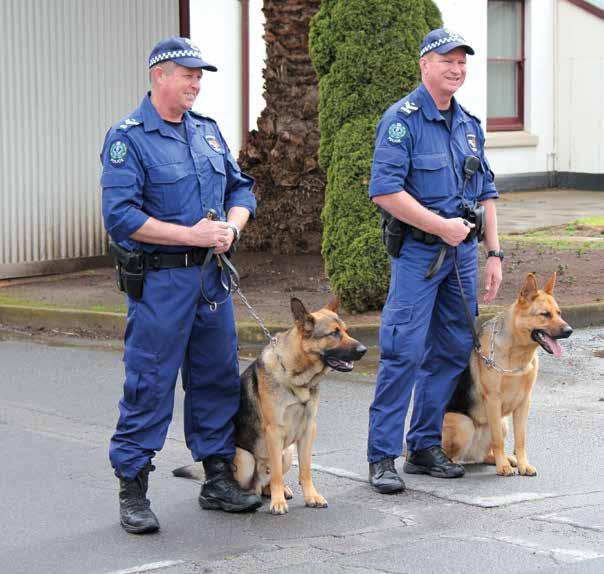
2
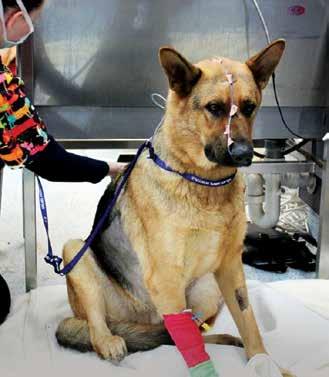
Potter watched the remainder of the surgery from a viewing area. He could see his beloved Ink with his chest cut wide open as Mason continued to operate. The scene struck him as “horrific”.
But a moment eventually came when Mason directed a thumbs-up gesture at Potter. That gave the worried handler at least some comfort.
The Potters hung around until the operation was over and, when Mason emerged from theatre, he assured them that the surgery had gone particularly well. He expected Ink to make a full recovery.
“But he had to stay in hospital for a while,” Potter recalls. “It ended up being 11 or 12 days, and then we took him home. ”
And it took Ink three months to make that full recovery and be fit enough to return to work. Once there, he got through a skills audit and back on the road with Potter, who was never to find him gun-shy.
“He was fine,” Potter says. “He didn’t shirk anything. I even went back to the scene of the attack and recreated it at night to see if anything spooked him. But, to him, it was just a location. It meant nothing.
“As far as giving him the command to go forth and engage, hunting crooks, and following the scent, he was back to being a police dog. ”
Indeed, over the next three years, Ink proved himself entirely up to the task. He wound up deployed 826 times and apprehended 56 offenders. One of his most memorable finds was a murder suspect who had fled from the scene of his crime at a Port Adelaide residence.
Not long into their search for him, Potter and Ink came to the edge of the Port River. Ink appeared “just up and staring, like an alert”, leading Potter to think: “We’re on!”
“I was looking and could see no disturbance in the water,” he says, “but the dog was on scent. I thought: ‘Is he (the offender) in here somewhere, or has he come this way?’ ”
The track seemed lost, so Potter headed back to the forward command post. And, while there, a local resident, whose house fronted the river, reported seeing a man emerge from the water and enter his front yard.

3
Potter, Ink and another police officer sprinted off toward the resident’s house. Ink regained the scent back at the river’s edge and followed it across several house fronts. He found the suspect hiding at the side of a house behind some bins.
His efforts helped bring about a murder conviction.
In another case, as Ink went about tracking a rape suspect in the western suburbs, he found a bandanna on the street. The victim identified the item as belonging to the suspect, and a later DNA test linked it to him as well. That evidence led to the suspect’s arrest.
Ink excelled in tracking the suspects of less serious offences as well. There were the two men who had undertaken their graffiti art in a four-storey city building under renovation.
Ink had found nothing in his search of all the floors and scaffolding. But, on the rooftop, he came to a low wall, stood on his hindlegs, and indicated toward the neighbouring rooftop.
“Nothing was clearly visible,” Potter says. “But police on cordons made their way to the other rooftop and found two offenders hiding behind air conditioning units. ”
Of course, Ink had his off-duty life as well, at home with the Potters, and it went on just as it had before the attack.
“He knew when it was ‘game on’,” Potter says, “but, when it wasn’t, he was a lovable, beautiful dog. He was a people dog, very approachable. ” have left Ink in any way incapable of work or play. But the veterinary advice had always been that he was likely to suffer spinal arthritis (degenerative joint disease).
And, during some routine training in 2016, Potter and his colleagues could see that Ink was “having some issues”. Subsequent X-rays confirmed the presence of arthritis. The consensus was to give Ink another 12 months of active duty and then transition him into retirement.
Before that time came, however, Potter had taken on his next German shepherd partner, Jax. And, once he had graduated, it was time for five-and-ahalf-year-old Ink to step down. He served his last day in policing on November 5, 2017.
But there was never a thought that he would live out his days anywhere but with the Potter family. SAPOL released him from its employ and signed him over to Potter.
That suited Ink perfectly, but he was still to face some heartbreak: the sight of the new Potter-Jax partnership going off to work without him. He would watch as the patrol car backed out of the driveway and the gates closed.
“And there’s Ink standing there,” Potter says. “The head would drop, and you’d think: ‘Oh shit, sorry, mate,’ because that’s all he’s known. ”
But Ink was not to suffer total boredom in his new stay-at-home life. Neighbour and firefighter David Green offered to take Ink on walks on the days when both Potter and Trish were working. He had himself owned German shepherds and not long lost his last one.
“That worked really well,” Potter says. “He almost had a second family. They loved him to death; and he got stimuli and attention while I wasn’t there. ”
Daily life, at home and at work, had fallen pretty well into place. Potter and Jax had bonded well; Ink and Jax got along fine at home; and Ink had that second family for company.
He still got the pleasure of walks with his master, too. But it was on those walks in 2020 when Potter noticed a certain lethargy about him. And it got worse.
Potter suspected it was a case of the arthritis worsening and so took Ink to the vet.
“And, within seconds,” he says, “they knew something was dramatically wrong. They pulled his lip up and there was no colour in his gum. Then they said: ‘We need to get oxygen into him quickly,’ and that’s when my heart sunk. ”
Ink was not producing red blood cells. He was suffering from leukaemia.
“I called my wife,” Potter says, “and, at that stage, I was out in the car losing it, and pacing around the block. I said: ‘You better get here because I don’t know if we’ll be taking Ink home.’ And she freaked out. ”
After Trish got to the vet surgery, Dr Simon Craig confirmed that Ink was producing no red blood cells and would soon die without treatment. But that treatment would involve multiple blood transfusions, for days in a row, and massive doses of steroids.
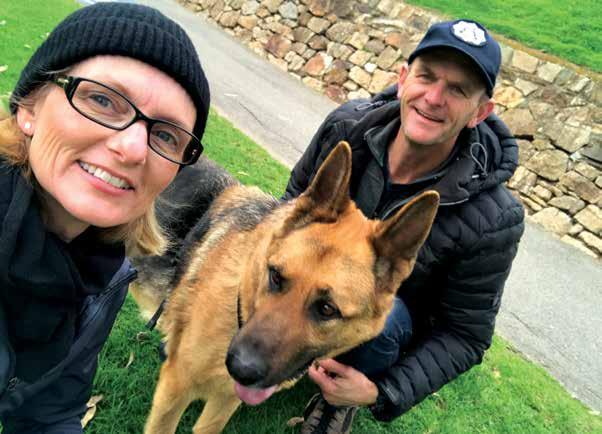
David and Jo Green who spent time with Ink in his retirement.
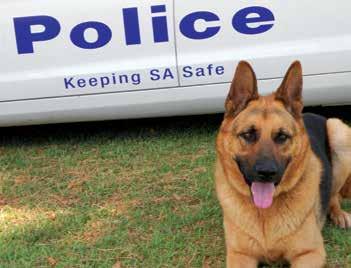

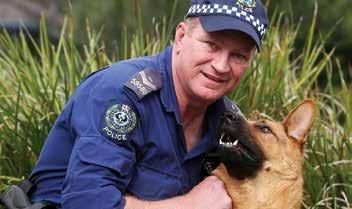
5
6
Trish, out of her deep love for Ink, backed that option and insisted that it proceed – at any cost. The equally anguished Potter, however, found the strength to consider the alternative both he and Trish dreaded.
He simply asked: “With all he’s been through, do we want to put him through anymore?” Then came a brief exchange between Potter and Craig. Potter: “What’s the go, mate?” Craig: “I’ve been doing this for 20-odd years, and I’ve never seen a dog recover from this. ” Potter: “That’s enough. I can’t put him through anymore. ”
“So, we made the decision,” Potter says, “to put him to sleep. I said to Simon: ‘I’ve never done this before. What do we do?’
“He said: ‘It’s very quick. It’s just an injection. The dog won’t be in any pain. ’
“I just gave him (Simon) the sign, and he said: ‘Now?’ And I just said: ‘Yeah.’ ”
The Potters moved to a consult room in which they were to have their last moments, agonizing as they would be, with Ink. They sat on the floor and cuddled him, as Potter whispered the words “good boy” to him.
“It was just to reassure him,” Potter says, “and to make sure we had physical contact with him, that he felt us there.
5: Ink in the parklands after some training. 6: Potter reunited with Ink on the day of his release from the animal hospital. 7: Ink’s ID photo from time he spent visiting Immanuel College. 7
“I was crying like a baby. I couldn’t control it. I just could not physically control it. And, because it was killing me, I said to Trish: ‘We’ve got to do this.’ So, I signalled to Simon: ‘Let’s do it.’ ”
Craig quickly restated the procedure he was about to follow and then gave Ink the injection.
“He was gone in less than 60 seconds,” Potter recalls, “but it was gentle. I saw his eyes going out and we were holding him as he died.
“Simon knew him well and just kept saying: ‘I'm so sorry.’ I said: ‘Mate, you’ve got nothing to be sorry about. I wanted someone who knew Ink to do it. ’
“We got up to exit by a side door and I said to Simon: ‘Will you look after Ink for me? Treat him well. ’
“We got his ashes and took them home about a week later. ”
Today, Potter works with Labrador drug dog Elly, but Ink is never far from his thoughts and, of course, remains in his heart.
Their relationship was, to him, so special that he finds it impossible to put into words, impossible to define.
But, after he took his mate’s ashes home, he knew just the place for them. It was a spot at his back gate where Ink used to sit and “watch the world go by”. And the indoor tribute to him was, and still is, his photo in the TV room at the back of the house.
“He has pride of place off to the side there,” Potter says. “So, we look at his smiling face often.” PJ
The attack on Ink came after the SA parliament had increased to five years the penalty for the offence of causing death or serious harm to working animals. Parliament amended the legislation after the stabbing of police dog Koda in 2013. The sentences handed down for the two offenders’ attack on Ink, and other offences, were five-and-a-half years with a two-and-a-half-year non-parole period, and four years with a two-year non-parole period – suspended.
Offender bites
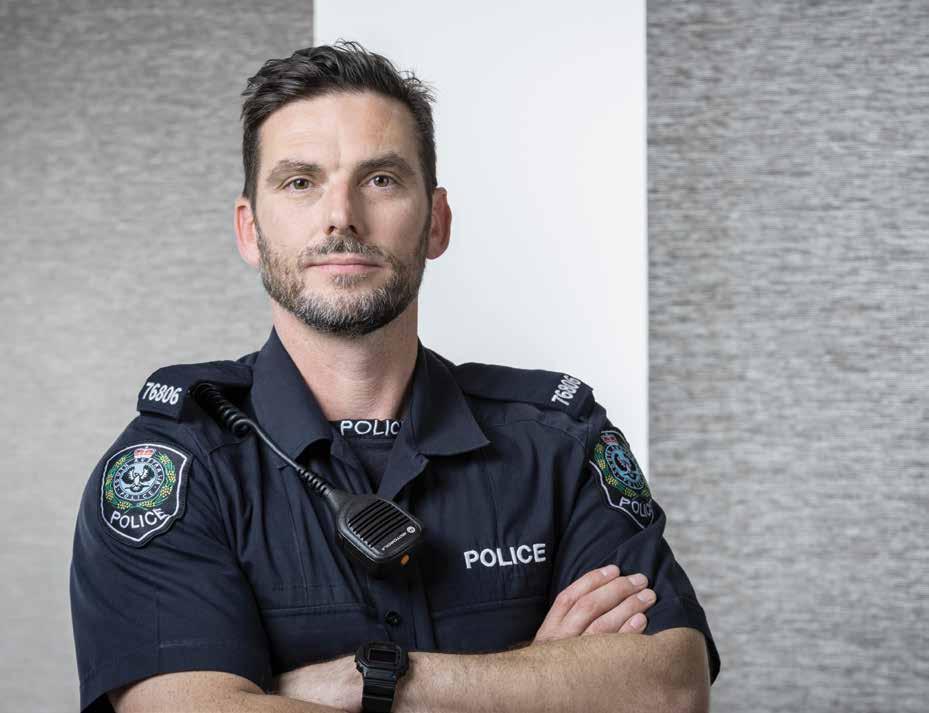
Constable Kent Derwent
Biting a police officer is a first rather than a last option for some offenders. And not in all cases are authorities taking blood samples from biters to check for communicable diseases.
By Brett Williams
Constable Kent Derwent spotted
the suspect he and his Norwood patrol partner had been searching for in Felixstow around 7:30am. Ibsen (not his real name) had positioned himself on the roof of a garden shed beneath a bough at the back of a Kapoola Avenue property.
The officers’ information was that an offender, armed with a knife or other edged weapon, had attacked a member of the public in the street.
Derwent could see that Ibsen matched the description witnesses had supplied on that March morning in 2019 and approached him. The two exchanged words before Derwent told his seemingly drug-affected suspect he was under arrest.
That drew an instantly combative response from Ibsen. “No, no, I’m fine,” he insisted. He made no move to turn around or position his hands behind his back, as Derwent had instructed.
Although alone with Ibsen, Derwent knew other officers were nearby on cordons and that a police dog and his handler were close by as well. So, he launched himself onto the shed roof and set about taking Ibsen in his grasp.
“Because I didn’t want him to run off,” Derwent says. “That was my thinking: ‘I need to be on this guy. ’
“I’ve gone hands-on with him and, in the process of trying to arrest him, we’ve wrestled and, somehow, I’ve ended up on top of him, restraining him. ”
Both men were at risk of tumbling off the shed roof as Ibsen moved to intensify rather than cease his resistance. He sunk his teeth deep into Derwent’s ring finger!
Derwent, then 43, felt “great force” in the painful, seconds-long bite, which penetrated his flesh despite the sturdy Mechanix glove he was wearing.
“(Then) he’s let go and I’ve withdrawn my finger, which he’s ripped open,” Derwent says.
But, still resistant, Ibsen lashed out with forceful kicks, which Derwent copped in the ribs.
“He was still being combative,” Derwent says, “so I’ve deployed OC spray. Then I’ve alighted from the roof and fence area and he’s come down to fight me again.
“So, I’ve drawn my baton and that’s when he complied. I then arrested him, and my colleagues arrived on scene. ”
Now free to check the damage to his finger, Derwent pulled the glove off his left hand and found “blood everywhere”. The bite had almost torn his fingernail clean off the quick.
Says Derwent: “It wasn’t until I had him in custody, took the glove off, saw the bite, the blood and the nail, that I thought: ‘This isn’t good!’ ”
But of some comfort to Derwent was that Ibsen’s teeth had not pierced the glove. That likely meant that no mouth-to-skin contact had occurred.
The other officers who had arrived on the scene bandaged Derwent’s wound after treating it with antiseptic.
Ibsen, soon after his attack on Derwent, underwent formal charging at the City Watch House. There, addressing the CWH sergeant, he claimed to have AIDS.
“And then,” Derwent says, “he turned to me and said: ‘I’ve got AIDS.’ That comment was purely to instil fear into me. And he added: ‘You’re screwed,’ or words to that effect.
“Initially, I dismissed it because crooks say that. They throw these terms around loosely. I had known from checks that he did have communicable diseases confirmed, but AIDS wasn’t listed as one of them. ”
With the charging process complete, Derwent went to Calvary Wakefield Hospital where he received further treatment to his finger. He also supplied a blood sample in line with protocol in cases of exposure to blood and other bodily fluids.
Taking blood from Ibsen, as legislation allowed, never came to fruition. The reason came to light in a letter from SAPOL to Police Association president Mark Carroll.
It explained that SAPOL medical staff had assessed the bite as a no-risk exposure and that “no benefit (was) to be obtained from blood testing of the suspect”.
That assessment, according to the letter, along with the non-compliant, violent behaviour of Ibsen, was the reason medical staff took no blood sample from him.
Derwent, to some extent, holds a similar view. “No one wants to put an RN at risk in terms of drawing blood from an aggressive offender,” he says.
The more frustrating issue to Derwent was the six-month wait he would have to undertake to find out if he had contracted any diseases. In those months, he could not enjoy physical contact in his private life, not even a simple embrace with his wife or children.
“It changes how you interact at home with everything,” he says. “And there were times when I thought: ‘This could go another way. And what would that mean for our family life, my life? Would it mean medication for the rest of my life?’ ”
Ultimately, however, Derwent emerged from the six-month wait clear of any diseases. And, today, his view on bite assaults is clear.
“The spitting and biting I just don’t think you ever get used to,” he says. “It’s a terrible human trait and no one should be subjected to that behaviour. ”
“Then,” Ross recalls, “she just stopped and screamed, turned, and ran straight at me. ” Mindful of the rich potential for a false allegation of excessive force, Ross decided to absorb rather than defend against the ramming tackle he expected. But rather than simply charge at him, the attacker lashed out with a punch to his face. “That knocked my hat and sunglasses clean off my head,” he says. “I still had my phone in my hand but dropped it and just went about trying to restrain her. “She was still landing quite a few punches as I tried to get her onto the ground and restrained. ” Once Ross gained control and was indeed taking Off-duty brevet sergeant Nathan Ross sprang into action after his attacker to ground, he felt something like a pinch to his left little finger. “It lasted barely a second, but I had that distinct he saw a woman taking a savage, unprovoked feeling that she’d bitten me,” he says. “My immediate beating on a city street. She was of mature age, reaction was to pull my arm straight out. She was supported by a walking frame, and bothering no then on the ground and I had her pinned. ” one. Before the attack on that hot January day last Ross was right: his attacker had indeed bitten year, she had been waiting quietly at a Grenfell St him, and she had broken his skin and instantly bus stop. drawn blood.
Now, she was defenceless under the barrage of But then came the first of multiple Hindley St punches her younger, female attacker was raining patrols charging along King William St toward Ross, down on her. And Ross, then 31, was not prepared to as did a cage car seconds later. One of the patrols just drive on and leave it to an untrained bystander arrested the offender for the assaults and took her to to defend the woman. the City Watch House.
He had seen her attacker moments before, as Ross wound up at Calvary Adelaide Hospital he was driving his car over King William St into where he got his wound cleaned up, a tetanus shot, Grenfell St. She had charged across to the southern and a sample of his blood taken. That was after a side of Grenfell St right in front of him. Ross had patrol had informed him that his attacker was had to slam on his brakes to avoid hitting her. positive for hepatitis C.
In his car with Ross, who pulled over around “SAPOL tried to organize a blood sample from 15 metres into Grenfell St, was his wife and baby her the next day,” Ross says. “Although they tried daughter. Intending to move in and stop the beating, and tried, it was just never going to happen because he asked his wife, as he stepped out of the car, to drive of previous damage to her veins. ” a lap of the block. So, for three months, Ross then had to keep himself
“At that point,” he says, “the offender stopped the distanced from his wife, daughter and others in his attack and walked back to where I first saw her, on private life. Physical contact with them was simply the northern side of the road. ” unsafe until a later blood test showed that he had
Ross followed her around the corner to the eastern not contracted any diseases. side of King William St, where she lay on the ground The inability to hug his daughter came as a second yelling obscenities. He identified himself to her as a agonizing blow to Ross. She had just a week earlier police officer and asked her why she had assaulted come out of a hip brace she had had to wear for three the other woman at the bus stop. She responded with: months from the age of six weeks. In that time, her “F--k off, dog. ” father had not been able to cuddle her.
Ross took out his phone, dialled 000, identified “So, she (the offender) stopped that connection himself to the operator, and asked for a patrol to assist between my daughter and me, and I’d only just got it him. The attacker then stood up and walked across to back,” he says. “That definitely took a toll on me. ” the western side of King William St as she continued Also disappointing to Ross was the freedom to hurl abuse at Ross. afforded his bite offender, whom he saw the next day
He followed her and, at the same time, stayed on as he rode to work. She was sitting on the footpath at the line and kept police communications updated as the same King William St intersection at the centre of the attacker headed toward Hindley St. the attacks. PJ


Virtual running race honours the fallen
By Nicholas Damiani
When Police Association member Brigitte Brooker saw Run4Blue appear on her social media pages, she knew it was an event in which she had to be involved.
The senior constable took on the role of promoting the virtual running race to SA cops — including on social media — after realizing it provided critical support to Police Legacy.
“I lost a family member when I was young, so I can understand how Legacy can change a person’s or family’s life for the better,” she said.
Run4Blue is a “virtual race” held annually in May to support Police Legacy which, in turn, supports the families of fallen police officers.
It encourages people to walk or run any distance — anywhere, any time — throughout the entire month of May.
2
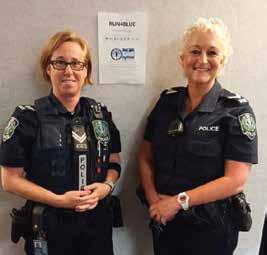
The event appeals to both police officers and the broader community.
And Snr Const Brooker’s efforts have helped Run4Blue grow significantly since its humble beginnings.
“In 2019, the first year of the event, it basically came down to word-ofmouth to spread the word in SA,” she reflected.
“But last year, it was promoted well, and supported fully by our leaders, and the registrations flourished. ”
With the world in an uncertain state for most of 2020, Run4Blue wound up being the perfect foil to raise much needed funds for the Legacy outlets in each state.
“This event was well suited for COVID-19 restrictions,” Snr Const Brooker said.
“There was a total of 144 SA registrations in 2020, with $108,770 raised for Police Legacy Australia-wide. ”
The race’s “virtual” nature makes Snr Const Brooker’s management of the online engagement a critical aspect of the promotion.
“A lot of participants post as they go on the Run4Blue pages and this keeps everyone connected and motivated,” she said.
“Some people also run in groups and post it online, which is great to see. ”
Snr Const Brooker said the event is a good opportunity for the community to experience positive interactions with cops.
“Absolutely anyone is welcome to join,” she said.
“And I think that the community love the fact that they can join in with police officers to participate in the event and can see all the event updates online.
“Last year we did little stories on social media with police officers, explaining why they got involved.
“I think this also made the community feel involved and part of a team. It also humanizes police officers, to bring positive interactions with us and the community. ”
The fledgling charity’s creation stems from an incredible chance meeting.
Co-founder and Northern Territory cop Tammy Watson told the Police Journal how a happy coincidence at the 2018 Australasian Police and Emergency Services Games in Mandurah led to the charity’s eventual start-up.
“That’s where I met (co-founder and WA cop) Natalee Cunningham,” she said.
The two cops’ mutual love of running sparked some conversations about virtual runs and Police Legacy, eventually leading to the creation of Run4Blue.
“We know the money we raise goes to support our legatees,” Senior Constable 1C Watson said. “So just knowing that we are doing our bit gives us the drive to keep going. ”
SC1C Watson said that participants choose which Police Legacy (state) they would like to support and how far they would like to walk or run.
“They have all of May (2021) to complete their goal,” she said.
“This year each participant gets their own fundraising page. They can also share it and raise additional funds. ”
Members can register at Run4Blue.net or visit the Run4Blue Facebook or Instagram page.
People unable to physically participate in Run4Blue can still donate any amount, which goes directly to Police Legacy. PJ

1
1: Run4Blue co-founders Senior Constable Natalie Cunningham (WA) and Senior Constable First Class Tammy Watson (NT). 2: Senior constables Brigitte Brooker and Corrina Hibbert.




